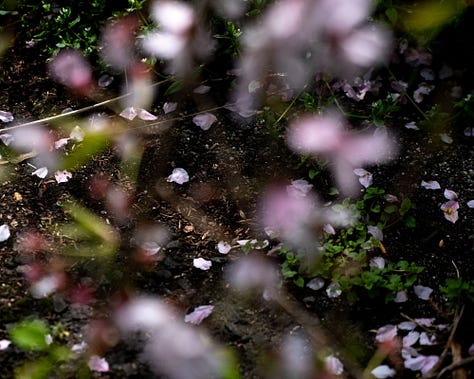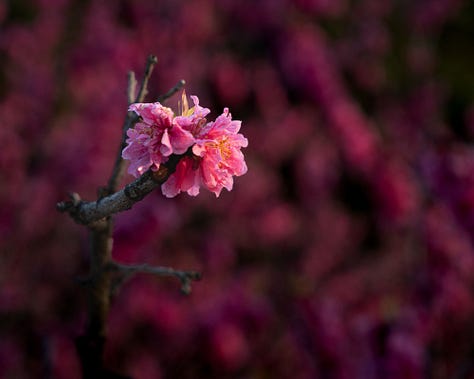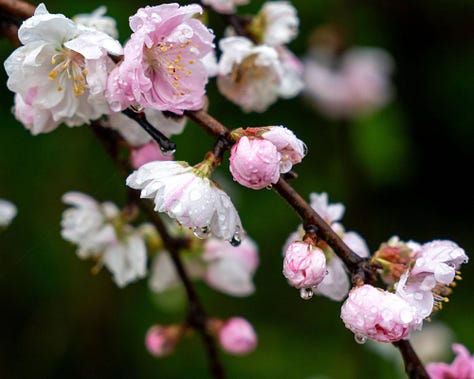A warm hello from Kamikatsu!
A couple of weeks have passed since my last update, but I’m here now and I’m grateful for you. I’m so grateful for this community of readers, writers, and thinkers. My words feel like they are falling short of the gratitude I want to express to everyone who continues to enjoy these fragmented moments.
Since living in the countryside, I’ve come to understand the passage of time through nature’s cycles, but it doesn’t often fit nicely into calendar days so I feel that I lean in on my senses to understand the shifts that happen. I recently had a conversation with a friend who moved to the village six years ago. I asked her what she enjoys most about living here, and her reply was about how the abundance of nature allows her to experience a place with all five senses. I resonated deeply with me.
The visual cues are the most obvious, especially in spring (especially, during cherry blossoms). Guided by senses, other than sight, is a beautiful way to experience a changing landscape. For Japanese people, the first chirps of the uguisu (Japanese bush warbler), a bird that is more often heard than seen, is a signal of the arrival of spring. We also see swallows making nests under roofs and hiding in nooks around the outside of houses.
Sakura blooming marks a new season, but so too does the petals falling. As the petals fall off the flower, a new vivid and vibrant green-colored leaf takes place. The brief encounter with the sakura is a reminder for Japanese people about the beauty of impermanence. It's easy to be mesmerized by the soft petals, especially during this time when they dance around in the breeze. Since the petals are so light and delicate, when a warm breeze comes the pedals float upwards like when you pick a dandelion puff and blow on it gently (fascinating physics behind a dandelion’s flight).
I can't help but think of tenderness when contemplating the beauty of the sakura (scroll to the bottom for more photos).
Source of water
This will be my third year of growing rice in Kamikatsu. Unlike other Southeast and South Asian countries, Japan, with its winters, can only harvest rice once a year. Some people believe this leads to better-tasting rice as the soil gets time to rest over the winter; others will say that water is the key to delicious rice.
While I have still so much to learn, each year I feel that I understand a little bit more about how the landscape and ecosystems need to be maintained to raise the stalks of rice for almost half a year. The more time I spend with and among the rice fields, I can see the interconnectedness of the mountains, rivers, and all the living creatures.
The terraced rice landscapes, and the changes they go through every year, are one of my favourite landscapes in the village. As much as I find comfort in the stillness of the winter seasons, there’s some magical about the movement of all living things in the spring and summer months.
Every April, the community that uses water in this area gathers to clear the irrigation channels fed by the mountain stream. Over 20 people came together to clean the canals and brush away forest debris like fallen leaves and stones that block the stream.
Rice cultivation in Japan originally flourished in terraced slopes, like Kamikatsu’s, because these places were easier to secure water supply. Kamikatsu has records that date back to the Edo period (over 250 years ago) that show that rice cultivation was taking place centuries ago.
While there are places in the world experimenting with cultivating rice without continuously flooding rice paddies or Masanobu Fukuoka (1913-2008), a pioneer of natural farming in Japan, who advocated for not flooding the fields, the area we grow our rice is blessed to be nearby a source of water in abundance.
Rice paddies have persisted as timeless subjects and sources of inspiration for Japanese art, poetry, and folklore for centuries. From the sight of small, green rice planted in neat rows in spring to the golden, tall stalks in autumn, these evolving images of rive evoke feelings of nostalgia for Japanese people. Even those who may not have grown up around rice fields probably feel the nostalgia similarly because it’s rooted in culture.
By making rice today, we contribute to preserving this natural and cultural landscape. Together, by being a part of these community efforts, we are working towards conserving our precious water source and being reminded of its importance. Stay tuned for rice farming updates!
And, as promised in the previous post, more photos of sakura! There were so many beautiful photos (I’m genuinely teary-eyed seeing these photos) that it was hard to choose only a few. My extra heartfelt ‘thank you’, Sil!



I hope that you are enjoying your surroundings with all five senses. Be fully present wherever you are. Have a beautiful weekend and week ahead!
With love,
Kana
















How lovely to find your post. We visited Kami Katsu last spring after we finished walking the Shikoku 88. We were lucky and heading north so caught several peak Sakura days as we headed north and sometimes up in altitude. I personally liked following the strawberry season also.
You mentioned seasonal changes in Japan. We used a beautiful free app 72 seasons, while we were in Japan https://www.kurashikata.com/72seasons/
but unfortunately it was discontinued this past February. Spoon and Tomago does have a 72 seasons email as a part of their annual membership ($50) https://www.spoon-tamago.com/japan-72-microseasons-newsletter/
which I might have to upgrade to, from their free newsletter, but would be interested in if you have any 72 seasons websites, apps, newsletters, or calendars to recommend.
I love the sensory experience of reading your post. I’ve never visited Japan and it helps me to understand the landscape and culture. Thank you for your beautiful insights 🌸